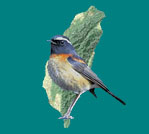|
Birds in Taiwan
Endemic Species
Collared Bush-Robin
Flamecrest
Formosan Magpie
Formosan Whistling-Thrush
Mikado Pheasant
Steere's Liocichla
Styan's Bulbul
Swinhoe's Pheasant
Taiwan Barwing
Taiwan Bush-Warbler
Taiwan Partridge
Taiwan Yuhina
White-eared Sibia
White-whiskered Laughingthrush
Yellow Tit
Endemic Sub-Species
Black-browed Barbet
Bronzed Drongo
Collared Finchbill
Hwamei
Oriental Skylark
Streak-breasted Scimitar-Babbler
Vinaceous Rosefinch
More Birds in Taiwan
Black-faced Spoonbill
Black-naped Oriole
Chinese Crested Tern
Crested Serpent-Eagle
Fairy Pitta
Japanese White-eye
Malayan Night-heron |
|
Hwamei
Garrulax canorus taewanus
Endemic subspecies
%20copy_small.jpg) The
[Taiwan] Hwamei is a medium-sized gray-brown laughingthrush, about 24 cm
long. The upperparts are olive grayish-brown; the buff crown and nape are
heavily streaked with dark brown; these streaks continue onto the mantle.
The flight feathers are dark brown with a chestnut wash. The tail is dark
brown with olive bars; the base of the tail is olive. The underparts, from
throat to breast, are yellowish-brown, with fine dark brown streaks. The
belly is grayish, and unstreaked. The
[Taiwan] Hwamei is a medium-sized gray-brown laughingthrush, about 24 cm
long. The upperparts are olive grayish-brown; the buff crown and nape are
heavily streaked with dark brown; these streaks continue onto the mantle.
The flight feathers are dark brown with a chestnut wash. The tail is dark
brown with olive bars; the base of the tail is olive. The underparts, from
throat to breast, are yellowish-brown, with fine dark brown streaks. The
belly is grayish, and unstreaked.
The vocalization of the male is a melodious, varied, lengthy whistled song,
“hseyu, hseyu, shou.”
[Taiwan] Hwamei live in pairs in dense brushy lowland. They are active in
understory scrub. The males are highly territorial.
Similar Species: Spot-breasted Scimitar-Babbler, 25 cm, with long, decurved
bill; white throat, and heavy, conspicuous black streaks restricted to the
white breast.
Streak-breasted Scimitar-Babbler, 21 cm, with white eyebrow, black lores,
white throat, black streaks on white breast extending to dusky flanks.
Reference: Field Guide: Birds of Taiwan; by Wang, J., C. Wu, G. Huang, X.
Yang, Z. Cai, M. Cai and Q. Xiao. 1991)
Hwamei (or Huamei) is sometimes called Melodious Laughingthrush or Chinese
Thrush. The Chinese word “Hwamei” translates into English as “paint brow”,
for the white eye-ring extending behind the eye. However, [Taiwan] Hwamei,
G. c. taewanus, does not have that feature.
,%20resize.jpg)
Hwamei
taewanus
Yao Cheng-Te, Taiwan Endemic Species Research Institute, Council of
Agriculture
The elaborate melodious song of male Hwamei has made them the most loved
caged bird in the Chinese history. As common residents inhabiting the
margins of lowland secondary evergreen woodlands, the Hwamei is widely
distributed in the central and southern China, northern Indochina, Hainan
and Taiwan (MacKinnon and Phillipps 2000). Taxonomically, three allopatric
subspecies have been described: G. c. canorus in Asia mainland, G. c.
owstoni in Hainan and G. c. taewanus in Taiwan (Berlioz, 1930, and Deignan
1964). Morphologically, G. c. taewanus is distinctive from the others by
lacking the distinct white eye-ring continuing behind the eye as a narrow
streak. In addition, plumage on the upperparts of G. c. taewanus is more
grayish in tone in contrast to the chestnut-brown of the other subspecies.
The crown and nape of G. c. taewanus are more heavily streaked. Compared to
G. c. canorus, G. c. owstoni has paler underparts and more olive upperparts.
Large number of G. c. canorus individuals have been collected to meet the
high market demand. To relieve this subspecies from the threat of
over-collecting, the G. canorus was listed in the Appendix III of CITES to
regulate its international trade in 2000. In addition to the
over-collecting, potential hybridization (between subspecies) and
introgression (between hybrids and their parental subspecies) may be other
threats to the survival of some Hwamei populations. Since the 1980s, when
the later subspecies was imported into Taiwan in large quantities, potential
hybrids between G. c. taewanus and G. c. canorus have frequently been
observed in Taiwan (Lucia L. Severinghaus, personal communication). The
viability of a population can be endangered by outbreeding depression,
breakdown of locally adapted genomic configuration, and loss of genetic
uniqueness through hybridization and introgression between evolutionary
distinctive lineages (evolutionary significant units, ESUs, Ryder 1986,
Moritz 1994) (Barrowclough and Flesness 1996, Rhymer and Simberloff 1996).
Consequently, G. c. taewanus was listed in the category of Other
Conservation-Deserving Wildlife in the Wildlife Conservation Law of Taiwan
since 1989. Due to the potentially severe genetic consequence of
hybridization and introgression, it is an increasingly urgent conservation
issue to identify the ESUs within the Hwamei and re-evaluate its
intraspecific systematic status.
|

